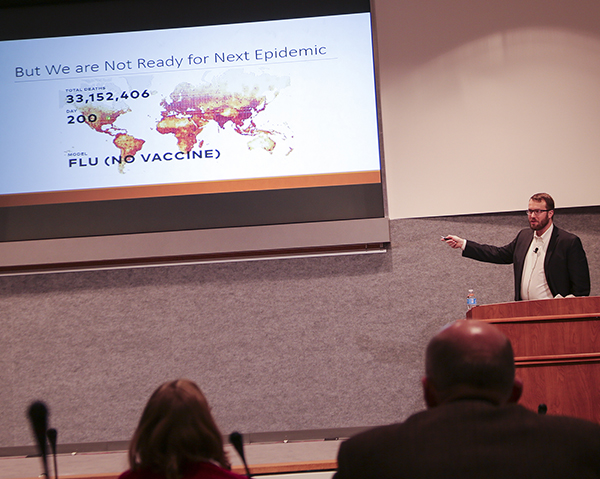
According to The Lancet, transmissible diseases such as tuberculosis, malaria, and HIV /AIDS claim more than 8 million lives each year.
In the second seminar in Sandia’s Science and Technology Speaker Series, held in late November, guest speaker Philip Eckhoff, director of research at the Institute for Disease Modeling, proposed that the best way to control these diseases is through total eradication.
Eckhoff compared the battle to keep diseases under control as a costly treadmill. Malaria control, for example, requires insecticide-laden bed nets, frequent spraying of insecticides inside houses, and prompt detection and treatment of those infected. These methods lead to mosquitos evolving insecticide resistance and the malaria parasite evolving drug resistance, which necessitates the development of new insecticides and treatments.The way off the treadmill is through complete eradication of a disease, but that is daunting task, Eckhoff said. In the face of the challenges, though, there have been some successes. The first eradication triumph was smallpox, completely eradicated in 1980. In 2010 rinderpest, a devastating cattle virus, was the second disease to be eradicated. With luck and continued effort, Eckhoff said, polio will join these two soon; it remains in only three countries — Pakistan, Afghanistan, and Nigeria.
Malaria eradication has been attempted several times in the past 60 years. The most recent attempt began in 2007. Eckhoff uses computer modeling to aid in prioritization and decision making. Fitting the model to the questions public health officials need to answer, Eckhoff’s team support an adaptive approach to eradicating malaria, he said.
For a large-scale demonstration, they are supporting work to eliminate malaria from southern Zambia. They are using a flexible and modular stochastic model with heterogeneous people plotted on a map. The model takes into account the mosquito life cycle and the effects of interventions such as bed nets, as well as representations of what is occurring inside the host.
Eckhoff concluded his talk with a broad bottom line: In addition to innovations in vaccines, medications, and detection tools, delivery and logistics innovations — such as using remote sensing to locate new, untreated households — are needed in the global eradication efforts.
The goal of Sandia’s Science and Technology Speaker Series is to bring prominent scientists and engineers to Sandia to present on their work and its significance to society.